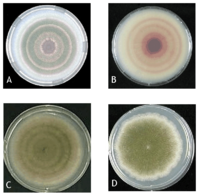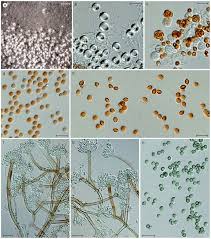Aspergillus nidulans
Classification
Domain: Eurkarya
Kingdom: Fungi
Division: Ascomycota
Class: Eurotiomycetes
Order: Eurotiales
Family: Tichocomaceae
Genus: Aspergillus
Species
Aspergillus nidulans
|
NCBI: Taxonomy |
Genus species

Description and Significance
A. nidulans is a form of filamentous fungi that has been found to serve as a valuable model organism in the realm of eukaryotic cell biology. Due to its ability to generate sexual spores via meiosis, researchers are capable of generating variable strains of the species. A. nidulans has been used to study a wide array of processes and topics such as cell cycles, mutations, infections, and evolutionary processes. [2] As a model organism, this species' diversified genome (unlike its relatives) allows for a more developed understanding of other species in the Aspergillus genus. Without A. nidulans, medical research concerning infections caused by its many sister species would be far more difficult to study. A. nidulans is credited with opening many doors for research of the entire genus of Aspergillus as well as for medical research in general.
Genome
A. nidulans was the first Aspergillus species to have its entire genome sequenced, and considering that A. nidulans is sexually reproductive, it contains a well-developed genetics system. Its genome is composed of 30 million base pairs in size with around 9,500 protein-coding genes on 8 different chromosomes [3].
Cell Structure, Metabolism and Life Cycle
A. nidulans is capable of producing sexual spores via meiosis, which allows for a more diversified collection of strains for the species. This sort of reproduction is not common within the Aspergillus genus. In addition, it is capable of forming fruiting bodies via self-fertilization. The wild type genotype of A. nidulans is green due to the coloration of its spores, but this color may vary amongst differing strains.

666 ORFs (or open reading frames) have been found to be associated with function in the species. The metabolic network of A. nidulans has been found to include 676 unique biochemical reactions as well as 113 different transport processes. [2] An A. nidulans colony begins with the germination of a spore. This spore will lead to the formation of tubular hyphae that continue to branch out forming a network of interconnected cells referred to as mycelium. This mycelium will grow in a symmetric, radial fashion indefinitely. Around 16 hours following germination, some of the colony’s internal branches begin to differentiate into asexual spore-bearing structures. [1]
Ecology and Known Roles in Symbiosis
Species in the genus Aspergillus are commonly found in many areas of life on earth, such as in soil, plant debris, water (freshwater or marine), or the air. [6] A. nidulans is one fo the Aspergilli that is known to cause infections in the lungs of various types of birds. Most commonly, pneumonia in young chicks and chronic pulmono-visceral disease in more mature hosts. In addition, A. nidulans is known to cause infections that lead to the mycosis of the guttural pouch in horses. [4]
Fun Facts
The use of A. nidulans as a model species allows for the understanding of other Aspergillus species (e.g., A. niger, A. oryzea, and A. flavus) which are medically significant. [5]
A. nidulans is the only species of the Aspergilli that is not asexual. [1]
The fruiting body of A. nidulans is capable of being many different colors. [2]
References
1 Adams, T. H., Wieser, J. K., & Yu, J.-H. (1998). Asexual Sporulation in Aspergillus nidulans. Microbiology and Molecular Biology Reviews, 62(2), 545–545. doi: 10.1128/mmbr.62.2.545-545.1998 https://mmbr.asm.org/content/62/1/35.full
2 David, H., Özçelik, I. Ş., Hofmann, G., & Nielsen, J. (2008). Analysis of Aspergillus nidulans metabolism at the genome-scale. BMC Genomics, 9(1), 163. doi: 10.1186/1471-2164-9-163 https://www.ncbi.nlm.nih.gov/pmc/articles/PMC2386489/
3 Galagan JE; et al. (2005). "Sequencing of Aspergillus nidulans and comparative analysis with A. fumigatus and A. oryzae". Nature. 438 (7071): 1105–15. doi:10.1038/nature04341. PMID 16372000. https://www.ncbi.nlm.nih.gov/pubmed/16372000
4 Gugnani, H. C. (2003). Ecology and taxonomy of pathogenic aspergilli. Frontiers in Bioscience, 8(6). doi: 10.2741/1002 https://www.researchgate.net/profile/Harish_Gugnani/publication/10800695_Ecology_and_taxonomy_of_pathogenic_Aspergilli/links/0912f5134ee52baa2e000000/Ecology-and-taxonomy-of-pathogenic-Aspergilli.pdf
5 Paulussen, C., Hallsworth, J. E., Álvarez-Pérez, S., Nierman, W. C., Hamill, P. G., Blain, D., … Lievens, B. (n.d.). Ecology of aspergillosis: insights into the pathogenic potency of Aspergillus fumigatus and some other Aspergillus species. https://www.ncbi.nlm.nih.gov/pmc/articles/PMC5328810/
Author
This page was authored by Dylan J Bartlett as part of the 2020 UM Study USA led by Dr. Erik Hom at the University of Mississippi.
